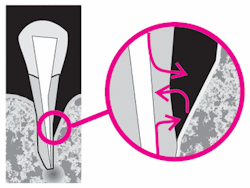Don't scratch the surface
Scaling and planing may sometimes not be the solution for periodontal lesions found adjacent to endodontically treated teeth.
by Larry Burnett, DDS
When sudden, deep, and vertical bone loss is discovered in an otherwise healthy mouth, two issues should be immediately considered. Are there any overhangs? Secondly, is the pocket adjacent to an endodontically-treated tooth?
If you're lucky, a defective amalgam will be acting as a plaque trap. Remove the overhang (for me, the easiest way is with a Power-Tip ultrasonic insert at maximum power). Next, debride the pocket, flush it with an antimicrobial agent, and the pocket will generally resolve itself.
Much more troublesome is the "endo" problem. In fact, the perio-endo lesion may be the most complex, recalcitrant, and localized problem we encounter. Over the years, a number of studies have observed that the bugs inhabiting a noncarious, nonvital pulp, bear a suspicious similarity to the microflora in an inflamed pocket.
Researchers are increasingly speculating that pathogens pass through the tooth via cracks, accessory canals, or open tubules. This cross-infection would explain why endodontically treated teeth with periapical lesions are particularly susceptible to localized bone loss. And it may also explain why severe periodontal lesions may be followed by chronic pulpitis or inexplicable death of the pulp.
In fact, some research suggests that a sharp, angular periodontal defect is a more reliable indicator of pulpal pathology than any of the traditional pulp tests. Incidentally, if valid, this endo-perio model also would explain why the lesion is so hard to treat. It's a complex lesion that involves a two-way septic highway of mutual reinfection.
Resolving the perio-endo lesion is outside the realm of conservative periodontics. It usually requires re-treatment of the canal — flaps, bone graphs, and sometimes even root amputation or extraction.
The reason I bring it up in this article is because old-time periodontal therapy (scraping and planing) may play a role in initiating this type of lesion. Remember, the hypothesis is that the endo-perio lesion involves transport of noxious substances through the tooth. Now historically, what have hygienists and dentists been taught to do when they encountered bleeding associated with bone loss? That's right. They sharpen those curettes and commence scaling and planing to remove the offending calculus and smooth those roots.
Scaling/planing removes tooth structure. First, it removes the protective cementum. Then, when that's gone, it starts removing the dentin itself.
But, of course, the real problem with an endo-perio lesion isn't the calculus or the irregular surfaces. It's bacterial communication through the root. So when we root-plane we're "treating" the problem by opening even more tubules and making the tooth even more permeable. The harder we try, the worse things get.
Attempting to treat a complex perio lesion by root planing may be like trying to put out a fire by dousing it with gasoline. It just makes matters worse.
Several recent studies in Australia and Scandinavia have suggested the danger of routinely scaling endodontically-treated teeth. If the direction hinted in these studies is substantiated by others, we may soon be reading that root-planing of nonvital teeth at recall appointments should be avoided. (And I would add, "And so should routine planing of most other teeth as well.")
Larry Burnett, DDS, is a graduate of the Medical College of Virginia School of Dentistry. He has authored numerous articles and lectured extensively on conservative periodontal therapy throughout the United States and Canada. A frequent speaker at the ADA annual scientific session, Chicago Midwinter, and Academy of General Dentistry meetings, Dr. Burnett is moderator of the Internet Perio Discussion Board and author of the video-based study program "Advanced Ultrasonics in General Practice" (Perioscope -1-800-888- 4941) . He can be reached at [email protected].
The proposed endo-perio mechanism
An infected canal reinfects the pocket, while the infected pocket reinfects the canal. Root planing will not help the situation and may make the root even more permeable.

